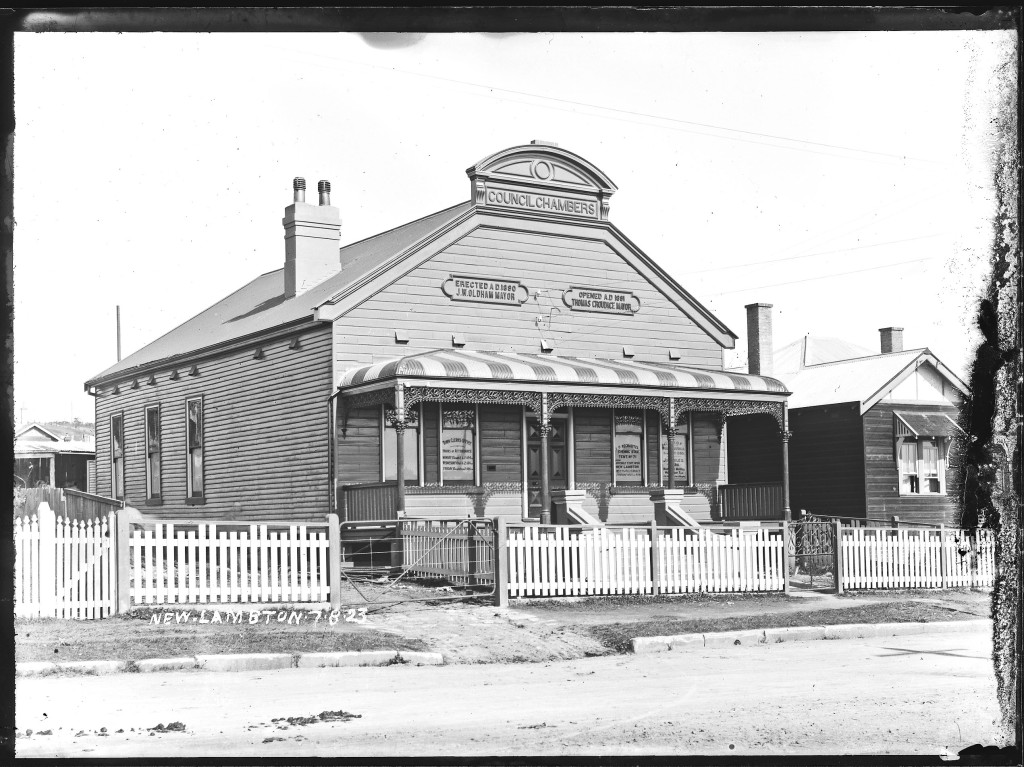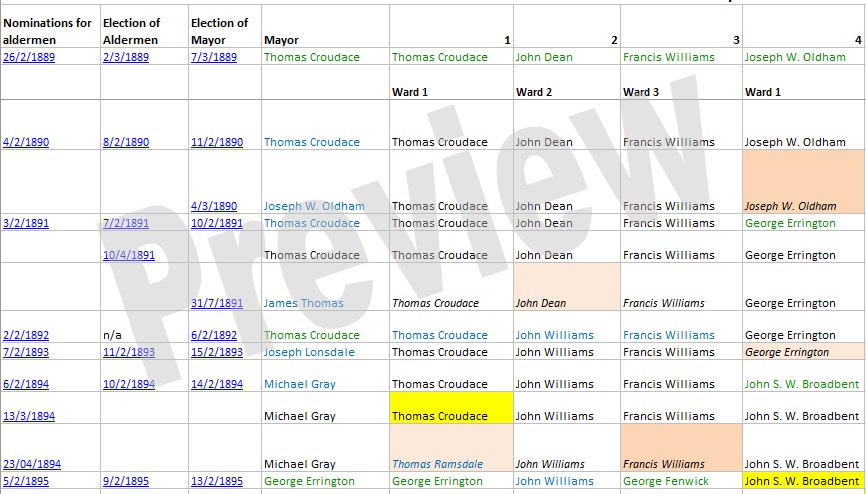New Lambton Council was incorporated on 9th January 1889 and remained until March 1938 when 11 local municipal councils merged to form the City of Greater Newcastle Council. During the 49 years of its existence, New Lambton Council had 83 different aldermen, 27 of whom served as mayor.
The file linked to below contains a summary of all the aldermen that served on New Lambton Municipal Council in the years 1889 to 1938.
Entries in the table that are underlined are hyperlinks to a relevant newspaper article in Trove. To make sense of the information in the summary document, it is helpful to understand how council elections were organised, and how I have used different text and background colours to represent changes in the council membership.

New Lambton Council Chambers and Town Clerks house, Lambton Road. Photograph by Ralph Snowball. University of Newcastle Cultural Collections.
Council elections
Elections in the New Lambton Municipal Council were initially governed by the NSW Municipalities Act of 1867. The council had 9 aldermen, who served terms of three years.
Initially the municipality was incorporated in 1889 without a ward system, but prior to the 1890 election, in response to a petition from the electors, the municipality was divided into three wards, with three aldermen to represent each ward. Each February the term of three aldermen expired (one from each ward), and nominations were called to fill the expiring positions, so that over a three year cycle the terms of all nine of the aldermen expired. If only one nomination was received for a particular ward, that nominee was automatically elected to the council without the need for a ballot. If there was more than one nomination in a ward the returning officer would set a date within the next seven days at which a ballot would be held, where the ratepayers of the council area would vote for aldermen.
The position of Mayor was not voted on by ratepayers, but rather on the first council meeting after the election, the nine aldermen (including the three newly elected/returned aldermen) would vote for who they wanted to be Mayor. In contrast to the position of aldermen who were elected to a term of three years, the position of Mayor had a term of only one year.
In the event of any casual vacancies, nominations for the vacancy would be called for, and an election called if there were more nominees than vacancies. Casual vacancies in New Lambton were caused by resignation, death, or a shortage of nominees at a scheduled election.
On 26/2/1906, the Municipalities Act (1897) was replaced by the Local Government Act (1906). The system of electing 3 aldermen each year was changed to elect 9 aldermen every 3 years. The election of a Mayor was still held each February, with the Mayoral term running from the first day of March to the last day of February.
In a December 1915 referendum, electors voted to abolish the ward system in New Lambton. Over the years the ward system had produced much dispute and accusations about some aldermen favouring expenditure of money in one ward over another.
Although there are numerous pieces of legislation relevant to local government in the period 1871 to 1938, the main acts relevant to the content on this page are:
- NSW Municipalities Act (1867)
- Local Government Act (1906)
- Local Government Act (1919)
- City of Greater Newcastle Act (1937)
Colour coding
In the documents I have used different colours to indicate the means by which people entered and exited council positions:
- The foreground text color indicates how a person entered a council position:
- Blue indicates the person was elected unopposed.
- Green indicates the person was a successful candidate in an election.
- Black indicates a continuation in office.
- The background colour of a table cell indicates how a person exited a council position:
- Yellow indicates a resignation.
- Light pink indicates expiration of a term, and the person did not seek re-election.
- Darker pink indicates expiration of a term, and the person was defeated when seeking re-election to another term.
- Light gray indicates that the person died while serving their term of office.
- For entries prior to 1906, where three aldermen retired each year, the names of the retiring aldermen are shown in italics.
Each new row in the table represents a change in the makeup of the council, with the exception of the council/mayoral elections of 1918, 1920, 1932, 1933, 1935, and 1936, where the aldermen and mayor remained unchanged.
Miscellaneous Observations
In the period 1889 to 1938:
- 27 different people served as Mayor.
- The longest serving Mayor was George Errington, who served a total of 7 years as Mayor during the period 1895 to 1914, on five separate occasions.
- The following Mayors have streets in New Lambton named after them – Errington, Dunkley, Croudace, Longworth. Alderman Mackie also has a street named in his honour. (Although there is a Marshall St in New Lambton Heights, it was named after James Gordon Marshall, a long time resident of that street, not the James Marshall who was Mayor of New Lambton who lived all his life in Clarence Road New Lambton.)
- In comparison with Lambton, New Lambton liked to share the Mayoral honours around. New Lambton council operated for 18 years less than Lambton council, but only had one fewer than Lambton’s 28 Mayors.
- Approximately 83 different people served as aldermen.
- The exact number is hard to be sure of. I have had to make some educated guesses as to whether aldermen with the same, similar, or variant names at different periods are the same person, or a different person.
- There are multiple variations of the spelling for Alderman Dunkley/Dunkeley/Dunckley/Dunckrley over a period 1894-1901. I have assumed it is the same person.
- There are two periods of office for William Coomer (1895-1896 and 1908-1913). The obituary of William Coomer in December 1931 states that he “served as an alderman for about four years”, which is suggestive that the 1895-1896 term was held by a different William Coomer. However the article also states that he had been a resident of New Lambton for 45 years, and being aged 74 years at his death in 1931, means that he was in the area and aged 38 years in 1895. So it is quite possible that he did serve the earlier term. In the absence of evidence to the contrary, I have assumed it is the same person.
- There are multiple variations of the spelling for Alderman Dunkley/Dunkeley/Dunckley/Dunckrley over a period 1894-1901. I have assumed it is the same person.
- The longest serving alderman was George Errington who served a total of 26 years and 2 months in the period 1891 to 1920, on four separate occasions.
- The shortest term of an aldermen was that of John Leyshon who was elected unopposed on 6 Feb 1894, and resigned just 15 days later on 21 Feb 1894, because he was leaving the district. The second shortest term of office was that of G. Richards who served for two months in May/June 1917. After the resignation of four aldermen had left the council without a quorum, Alderman Richards volunteered to fill one of the vacancies, and allow council to continue to operate until the scheduled election on 30 June 1917.
- The exact number is hard to be sure of. I have had to make some educated guesses as to whether aldermen with the same, similar, or variant names at different periods are the same person, or a different person.
- This page is titled “New Lambton Aldermen“, for they were all men. For most of the life of the council, this was by law, for while both men and women were entitled to vote, the Municipalities Act of 1867 and the Local Government Act of 1906 was explicit in restricting council service to men. e.g. section 69 of the 1906 act says:
“Any male person whose name is on the roll of electors for an area shall, if not disqualified, be eligible to be elected and to act as alderman or councillor of the area.”
By the time of the Local Government Act of 1919, this gender exclusion for office was no longer in place, however in the remaining 20 years no women were nominated for or elected to New Lambton Council. - Three people died while serving in office, George Fenwick in 1895, Richard Lay in 1903, and George K. Morison in 1927.
- There were 24 occasions when an alderman or mayor resigned their position. In most cases the reason was that the person had left the district, or because of ill health, or because other personal matters did not allow them to attend to council business. The biggest combined resignations occurred in 1917, when three aldermen (Milligan, Edden, Lock) having served their three years objected to having their term of office extended by five months by the State Government because of changes to the electoral provisions for voter franchise. A subsequent resignation by Alderman Jordan left the New Council inoperative for a month as there were insufficient aldermen to form a quorum at council meetings.


Hello
Enjoy your articles in the Local
(New Lambton Aldermen) I have an image you maybe interested in using on your website. It has been in the family for as long as I can remember. It is aldermen and workers of New Lambton Council standing next to a steam truck in 1924 on the steeper parts of either Russell Road or Victoria Street New Lambton.
Many years ago I let Newcastle Herald Journalist Greg Ray use it in his articles.